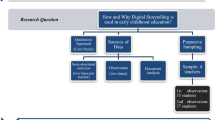Abstract
Educational game designers and educators are using digital games as a platform for teaching academic content, including multicultural curriculum. However, it is unclear how well digital game-based learning can coexist with the goals of multicultural education for the purpose of meeting the needs of African American children. In this essay, we raise serious questions about the use of digital games to teach about social oppression in ways that privilege the psychological well-being of African American children. We argue that digital games that intend to recreate histories of racial oppression can be harmful to African American children if they reproduce popular and problematic notions of indigenous lives and experiences. We illuminate some of the dangers of such digital games through a preliminary exploration of one digital game designed to teach about facets of African American enslavement. Our essay concludes with recommendations for culturally relevant digital game-based learning design and instruction.
Similar content being viewed by others
Notes
References first author.
Refers to individuals of African ancestry. Will be used interchangeably with the term Black.
References
Acosta, M. M. (2015). “No time for messin’ around!” Black educator urgency and Implications for the preparation of urban educators. Urban Education. https://doi.org/10.1177/0042085915613545.
Acosta, M. M., Johnson, B. G., Hudson-Vassell, C., Hudson-Vassell, M., & Hosby, J. (2016). Casualties in the classroom: How CRT is weaponized to safeguard white supremacy. In V. Stead (Ed.), RIP Jim Crow: Fighting racism through higher education policy, curriculum, and cultural interventions. New York: Peter Lang Publishing.
Adams, E. (2003). Not just rappers and athletes: Minorities in video games. Gamasutra. Retrieved from http://www.gamasutra.com/features/20030827/adams_pfv.htm.
Arena, D. A., & Schwartz, D. L. (2014). Experience and explanation: Using videogames to prepare students for formal instruction in statistics. Journal of Science Education and Technology, 23(4), 538–548.
Bell, D. (1992). Faces at the bottom of the well: The permanence of racism. New York: Basic Books.
Boutte, G. (2015). Educating African American children: And how are the children?. New York: Routledge.
Brock, A. (2011). “When Keeping it Real Goes Wrong”: Resident evil 5, racial representation, and gamers. Games and Culture, 6(5), 429–452. https://doi.org/10.1177/1555412011402676.
Davis, R. (2015). Is a slave simulation game appropriate for classrooms? EdSurge. Retrieved from https://www.edsurge.com/news/2015-02-17-opinion-slave-simulation-an-edtech-game-for-classrooms.
Denham, A. R. (2013). Strategy instruction and maintenance of basic multiplication facts through digital game play. International Journal of Game-Based Learning, 3(2), 36–54.
Denham, A. R. (2015). Supporting conceptual understanding of the associative and distributive properties through digital gameplay. Journal of Computer Assisted learning, 31(6), 706–721.
Devlin, K. (2011). Mathematics education for a new era: Video games as a medium for learning. Boca Raton: CRC Press.
Dill, K. E., Gentile, D. A., Richter, W. A., & Dill, J. C. (2005). Violence, sex, race and age in popular video games: A content analysis. Featuring females: Feminist analyses of the media. Washington, DC: American Psychological Association.
Everett, A., & Watkins, C. (2008). The power of play: The portrayal and performance of race in video games. In K. Salen (Ed.), The ecology of games: Connecting youth, games, and learning (pp. 141–166). Cambridge, MA: The John D. and Catherine T. MacArthur Foundation Series on Digital Media and Learning.
Foster, M. (1993). Educating for competence in community and culture: Exploring the views of exemplary African American teachers. Urban Education, 27, 370–394.
Gee, J. P. (2005). Learning by design: Good video games as learning machines. E-Learning and Digital Media, 2(1), 5–16.
Giroux, H. A. (1996). Counternarratives: Cultural studies and critical pedagogies in postmodern spaces. New York: Routledge.
Habgood, M. J., & Ainsworth, S. E. (2011). Motivating children to learn effectively: Exploring the value of intrinsic integration in educational games. The Journal of the Learning Sciences, 20(2), 169–206.
Higgin, T. (2009). Blackless fantasy: The disappearance of race in massively multiplayer online role-playing games. Games and Culture, 4(1), 3–26. https://doi.org/10.1177/1555412008325477.
Hill-Collins, P. (2000). Black feminist thought: Knowledge, consciousness, and the politics of empowerment. New York: Routledge.
Howard, T. (2001). Powerful pedagogy for African American students: A case of four teachers. Urban Education, 36(2), 179–202.
Janks, H. (2013). Critical literacy in teaching and research. Education Inquiry, 4(2), 225–242.
Juul, J. (2013). The art of failure: An essay on the pain of playing video games. Cambridge: MIT Press.
Kato, P. M., Cole, S. W., Bradlyn, A. S., & Pollock, B. H. (2008). A video game improves behavioral outcomes in adolescents and young adults with cancer: A randomized trial. Pediatrics, 122(2), e305–e317.
Kebritchi, M., Hirumi, A., & Bai, H. (2010). The effects of modern mathematics computer games on mathematics achievement and class motivation. Computers & Education, 55(2), 427–443.
Ladson-Billings, G. (1994). The dreamkeepers: Successful teachers of African American children. San Francisco, CA: Jossey-Bass.
Landsman, J. (2009). A white teacher talks about race. Langham, MD: Rowman & Littlefield Publishers.
Leonard, D. (2003). Live in your world, play in ours: Race, video games, and consuming the other. Studies in Media & Information Literacy Education, 3(4), 1–9.
Leonard, D. (2004). High tech blackface: Race, sports, video games and becoming the other. Intelligent Agent, 4(4.2), 1.
Leonard, D. J. (2006). Performing blackness: Virtual sports and becoming the other in an era of white supremacy. In M. Flanagan & A. Booth (Eds.), Re: Skin (pp. 321–353). Cambridge: MIT Press.
Lewison, M., Leland, C., & Harste, J. (2014). Creating critical classrooms: Reading and writing with an edge. New York: Routledge.
Milner, R. H. (2008). Critical race theory and interest convergence as analytic tools in teacher education policies and practices. Journal of Teacher Education, 59(4), 332–346.
Morrison, T. (1992). Playing in the dark: Whiteness and the literary imagination. Boston, MA: Harvard University Press.
Papert, S. (1998). Does easy do it? Children, games, and learning. Game Developers Magazine, 5(6), 88.
Peller, G. (1995). Race consciousness. In K. Crenshaw, N. Gotanda, G. Peller, & K. Thomas (Eds.), Critical race theory: The key writings that formed the movement. New York: New Press.
Perry, T. (2003). Up from the parched earth: Toward a theory of African-American achievement. In T. Perry, C. Steele, & A. G. Hilliard III (Eds.), Young, gifted and Black: Promoting high achievement among African-American students (pp. 1–108). Boston: Beacon.
Rosser, J. C., Lynch, P. J., Cuddihy, L., Gentile, D. A., Klonsky, J., & Merrell, R. (2007). The impact of video games on training surgeons in the 21st century. Archives of Surgery, 142(2), 181–186.
Scanlon, M., Buckingham, D., & Burn, A. (2005). Motivating maths? Digital games and mathematical learning. Technology, Pedagogy and Education, 14(1), 127–139.
Shute, V. J., & Ke, F. (2012). Games, learning, and assessment. In D. Ifenthaler, D. Eseryel, & X. Ge (Eds.), Assessment in game-based learning (pp. 43–58). New York: Springer.
Siddle-Walker, V. (2000). Valued segregated schools for African American children in the South, 1935–1969: A review of common themes and characteristics. Review of Educational Research, 70(3), 253–285.
Sterling, D. (1997). We are your sisters: Black women in the nineteenth century. New York: W. W. Noble & Company.
Uttal, D. H., Meadow, N. G., Tipton, E., Hand, L. L., Alden, A. R., Warren, C., et al. (2013). The malleability of spatial skills: A meta-analysis of training studies. Psychological Bulletin, 139(2), 352.
Van Eck, R. (2006). Digital game-based learning: It’s not just the digital natives who are restless. EDUCAUSE Review, 41(2), 16.
Ware, F. (2006). Warm demander pedagogy: Culturally responsive teaching that supports a culture of achievement for African American students. Urban Education, 41(4), 427–456.
Weststar, J., & Legault, M. (2015). Developer satisfaction survey 2015: Summary report. Retrieved from http://c.ymcdn.com/sites/www.igda.org/resource/collection/CB31CE86-F8EE-4AE3-B46A-148490336605/IGDA%20DSS%202015-SummaryReport_Final_Sept15.pdf.
Williams, D., Martins, N., Consalvo, M., & Ivory, J. D. (2009). The virtual census: Representations of gender, race and age in video games. New Media & Society, 11(5), 815-834.
Woodson, C. G. (1933). The mis-education of the Negro. Washington, DC: Associated Publishers.
Wynter, S. (1994). No humans involved: An open letter to my colleagues. Forum NHI: Knowledge for the 21st century, 1(1), 246–273.
Author information
Authors and Affiliations
Corresponding author
Rights and permissions
About this article
Cite this article
Acosta, M.M., Denham, A.R. Simulating Oppression: Digital Gaming, Race and the Education of African American Children. Urban Rev 50, 345–362 (2018). https://doi.org/10.1007/s11256-017-0436-7
Published:
Issue Date:
DOI: https://doi.org/10.1007/s11256-017-0436-7




